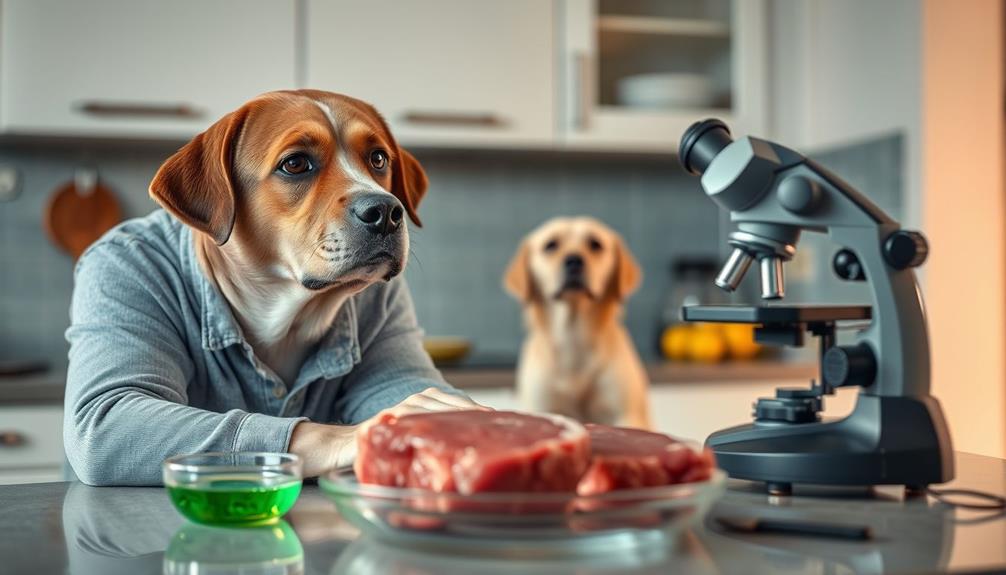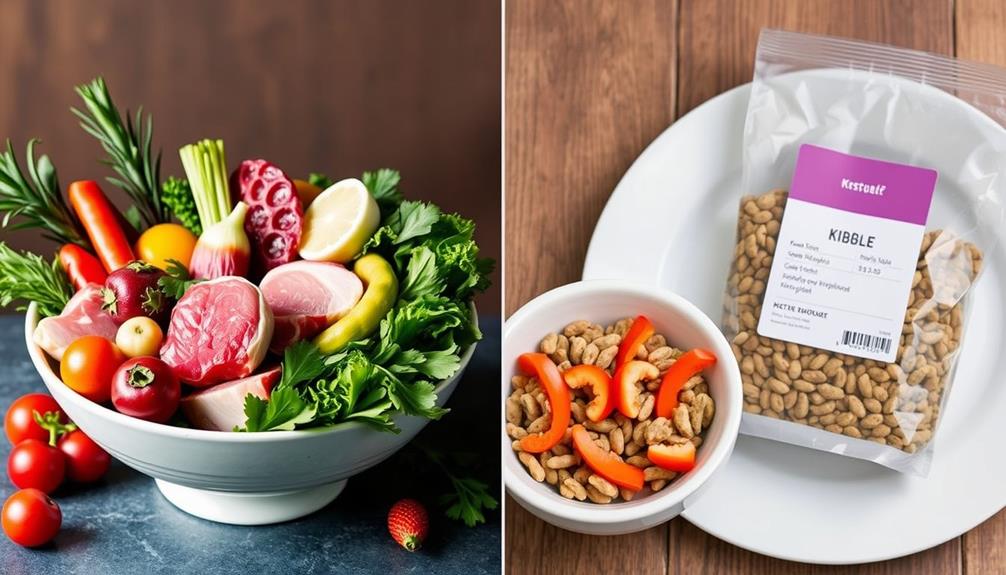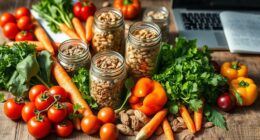Yes, raw food can definitely increase the risk of urinary tract infections (UTIs) in dogs. This mainly happens due to antibiotic-resistant bacteria like E. coli found in raw meat. When dogs eat raw diets, they can shed these harmful bacteria, which may even transfer to you. Elevated urine pH from raw diets can also contribute to complications like struvite crystals, making infections more likely. To guarantee your dog's health, consider safer feeding methods and proper hygiene practices. There's plenty more to explore about the impact and management of raw diets for your furry friend. While there are risks associated with raw food diets for dogs, it’s also important to consider the benefits of feeding raw dog food. Many owners believe that raw diets provide a more natural and nutrient-rich option for their pets, with potential improvements in coat quality, energy levels, and overall health. However, it is crucial to weigh these potential benefits against the increased risk of UTIs and other health complications when deciding on the best diet for your dog. It’s always best to consult with a veterinarian to find the most suitable and safe feeding approach for your furry companion.
Key Takeaways
- Raw food diets can lead to the shedding of antibiotic-resistant E. coli, increasing urinary tract infection (UTI) risks in dogs.
- E. coli strains associated with raw meat diets are linked to persistent UTIs that complicate treatment.
- Elevated urine pH from raw diets can promote struvite crystal formation, further heightening UTI risk.
- Proper hygiene practices during raw food handling are essential to minimize bacterial transmission to both dogs and owners.
- Consulting veterinarians about raw diet safety and considering cooked alternatives can reduce bacterial infection risks.
Understanding Raw Dog Food Risks
When you consider feeding your dog a raw food diet, it's vital to understand the associated risks. Raw dog food, especially undercooked meat, can lead to the excretion of resistant bacteria, like ciprofloxacin-resistant E. coli. This not only raises health risks for your dog but also for you, as these resistant strains can contribute to urinary tract infections (UTIs) in both pets and their owners.
Additionally, cold medications overview highlights the importance of selecting the right treatment options, which can be relevant if your dog experiences complications from infections. A study from the University of Bristol highlights a significant correlation between dogs fed raw meat diets and the shedding of these dangerous bacteria.
E. coli can linger in your dog's intestines for years without causing illness, but when infections do arise, treatment can become complicated. Additionally, the presence of pathogens in raw meat can elevate the risk of bacterial infections, further increasing the likelihood of UTIs.
Good hygiene practices are imperative when handling raw diets. Poor hygiene during feeding can facilitate bacterial transmission, leading to infections. By understanding these risks and adopting proper feeding practices, you can help minimize the potential health hazards associated with feeding your dog raw food.
E. Coli and Antibiotic Resistance

E. coli is a notorious culprit behind urinary tract infections (UTIs) in dogs, and certain strains of this bacteria are directly linked to raw meat diets. Studies, like one from the University of Bristol, have shown a significant correlation between dogs fed raw meat and the excretion of ciprofloxacin-resistant E. coli. When considering a raw meat diet for your dog, it’s important to consult with a veterinarian to ensure the safety and quality of the food. The best raw food for dogs will be carefully sourced and prepared to minimize the risk of bacterial contamination. Additionally, monitoring your dog’s health and discussing any concerns with a professional can help mitigate the potential risks associated with raw meat diets.
This situation underscores the importance of understanding common financial terms, as managing your pet's healthcare can impact your overall budget. Furthermore, the potential for increased veterinary costs due to complications from antibiotic-resistant infections can strain finances further.
The health risk extends beyond just your dog; the presence of resistant bacteria in pets can lead to bacteria transmission to humans, especially if hygiene practices aren't followed when handling pet feces.
As the World Health Organization highlights, high levels of fluoroquinolone use, including ciprofloxacin, contribute to rising resistance rates globally. This means that not only are your dogs at risk, but so are you and your loved ones.
Choosing a raw meat diet for your dog may seem appealing, but the implications of antibiotic-resistant E. coli can have far-reaching consequences, complicating health for both pets and their owners.
Be aware of these risks when considering your dog's diet and overall health strategy.
Impact on Urinary Health

The impact of raw food diets on urinary health in dogs can be significant, particularly regarding the risk of urinary tract infections (UTIs). When you feed your dog a raw diet, you might unknowingly increase their exposure to antibiotic-resistant bacteria, like E. coli. Studies, such as one from the University of Bristol, show a strong link between raw meat and the presence of resistant E. coli in your dog's feces. Possible reasons for refusing raw food diets for your dog can include concerns about bacterial contamination, the potential for nutrient imbalances, and the risk of feeding bones leading to gastrointestinal obstruction or dental damage. Additionally, some pet owners may be worried about the lack of scientific evidence supporting the health benefits of raw diets for dogs. As a result, it is important for dog owners to carefully consider the potential risks and benefits before deciding to feed their pets a raw food diet.
Additionally, proper diet management is vital, as certain foods can affect your dog's overall health and wellbeing, including their urinary system, making it important to research ultimate hamster care to understand dietary needs.
Moreover, the pH levels in your dog's urine can be affected by their diet. Raw food, especially those high in grains or starches, can lead to elevated urine pH, promoting the formation of struvite crystals. This can further heighten the risk of UTIs.
While many pet owners believe raw diets boost overall health, there's little scientific evidence supporting better urinary health, and the potential for bacterial contamination is a real concern.
To maintain your dog's urinary health and minimize the risk of recurrent infections, proper hydration and thoughtful diet management are vital. It's important to take these factors into account before committing to a raw food diet for your furry friend.
Recommendations for Safe Feeding

How can you guarantee your dog's safety while feeding a raw diet? First, consider sourcing high-quality raw meat that's safe for your pet. Cooking raw meat before feeding can greatly reduce the risk of harmful bacteria, including antibiotic-resistant E. coli, which can lead to urinary tract infections (UTIs).
It's also important to be aware of the potential financial considerations for your pet's healthcare, as financial planning for care can help you manage any unexpected health issues. If you choose to stick with raw, it's vital to practice good hand hygiene when handling the meat to prevent bacterial transmission.
Consult your veterinarian about where to source your meat. Farms that use low or no antibiotics can help minimize your dog's exposure to resistant bacteria. Additionally, regular veterinary check-ups are indispensable. They allow for monitoring your dog's urinary health and can help you catch any potential issues early.
When feeding a raw diet, always be aware of the risks involved. Safe feeding practices and ongoing veterinary guidance can help protect your dog from UTIs and guarantee they stay healthy.
Insights From Veterinary Professionals

When it comes to feeding your dog a raw diet, insights from veterinary professionals reveal critical considerations for your pet's health. Many experts have observed a concerning link between raw meat diets and the excretion of antibiotic-resistant E. coli in dogs, which poses significant health risks for both pets and their owners.
Studies show that dogs on raw diets are at a higher risk for urinary tract infections (UTIs), primarily due to harmful bacteria that often accompany undercooked meat. Additionally, similar to emotional dysregulation seen in Borderline Personality Disorder (BPD), dogs may exhibit behavioral changes due to the discomfort caused by UTIs and infections emotional dysregulation in pets.
Veterinary professionals recommend consulting multiple veterinarians to evaluate the nutritional adequacy and safety of raw feeding, as opinions can vary widely. Some veterinarians caution against raw diets, suggesting that cooked alternatives may effectively reduce the risk of bacterial infections, including UTIs.
They emphasize that while raw feeding might seem appealing, further research is necessary to establish a clear link between diet and urinary health.
Ultimately, prioritizing your dog's health means considering these insights from veterinary professionals. By weighing the potential risks of raw meat against the benefits of cooked alternatives, you can make informed decisions that promote your pet's well-being.
Frequently Asked Questions
Can Raw Food Cause Infection in Dogs?
Feeding your dog raw food can indeed lead to infections. The bacteria present in raw meat might cause gastrointestinal issues, and resistant strains can linger, increasing the risk of infections for both your pet and you.
What Foods Contribute to UTI in Dogs?
Have you ever wondered which foods might lead to UTIs in dogs? High-grain diets, ultra-processed kibble, and certain vegetables like broccoli can increase urine pH, creating an environment ripe for infection. Choose wisely!
What Is the Most Common Cause of UTI in Dogs?
The most common cause of UTIs in dogs is bacteria, primarily E. coli, entering the urinary tract. Factors like your dog's gender, age, and health conditions can increase susceptibility, making proactive care essential.
Can Dog Food Cause Urinary Problems?
Imagine your dog maneuvering a maze of food choices. If you choose high-carb kibble, you might unwittingly lead them to urinary troubles. Balanced diets and hydration can help them find their way to health.
Conclusion
In summary, while raw dog food can offer many benefits, it also brings potential perils, particularly regarding urinary health. You should stay savvy about sourcing safe selections and steer clear of unsanitary practices. Prioritize your pup's well-being by consulting veterinary professionals and following feeding recommendations. With the right knowledge and careful choices, you can guarantee a healthy, happy hound. So, let's keep those critical canines clean and clear of infections!










